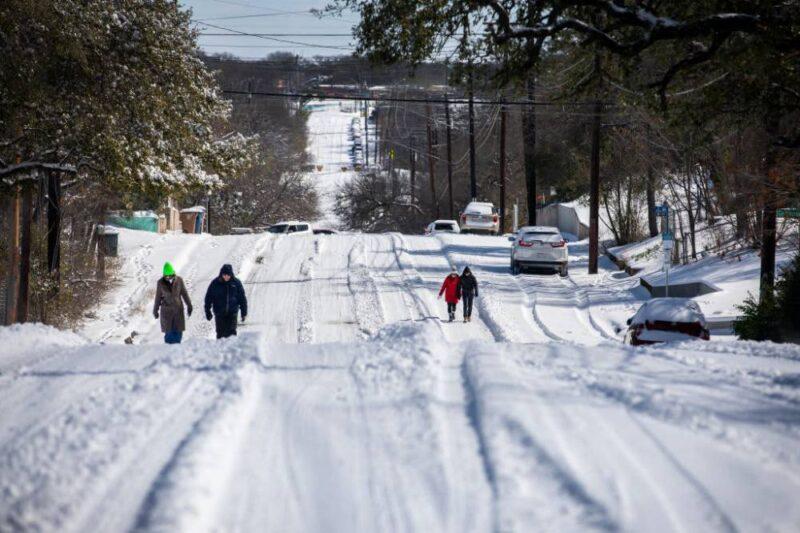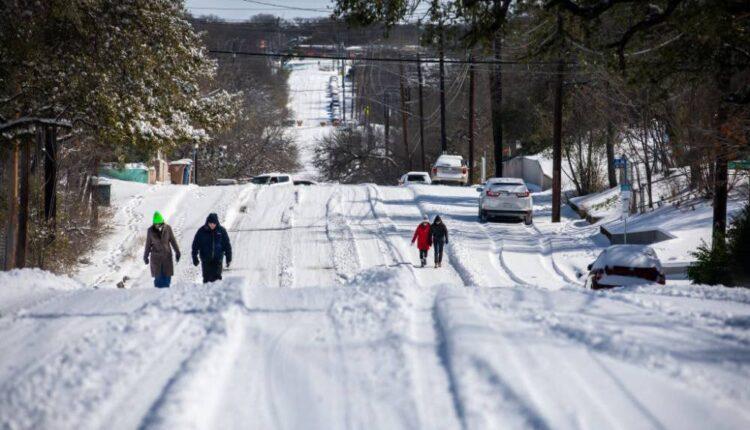
- More than 4 million people were without power in Texas on Tuesday morning, according to poweroutage.us.
- Gas prices shot up amid higher demand.
- "The majority of heating needs are met via electrical baseboard or heat pumps in the southern region," said John Kilduff, founding partner at Again Capital. "The demand for electricity over the weekend rivaled peak summer heat-wave levels."
Pedestrians walk on an icy road on February 15, 2021 in East Austin, Texas. Winter storm Uri has brought historic cold weather to Texas, causing traffic delays and power outages, and storms have swept across 26 states with a mix of freezing temperatures and precipitation.Montinique Monroe | Getty Images
Energy prices jumped Tuesday as a deep freeze in the South boosted demand for fuel and hampered production.
More than 4 million people were without power across Texas on Tuesday morning, according to poweroutage.us, as the electric grid couldn't keep up with heightened demand, forcing utilities to implement rolling blackouts in some cases.
"The majority of heating needs are met via electrical baseboard or heat pumps in the southern region," said John Kilduff, founding partner at Again Capital. "The demand for electricity over the weekend rivaled peak summer heat-wave levels."
Henry Hub natural gas futures jumped 6.7% to trade at $3.106 per million British thermal units. Gasoline futures advanced more than 4%.
"The storm that has crippled the Midwest and Northeast was much worse than expected," said Jeff Kilburg, CEO at KKM Financial. "Frigid temps and speculators caught short are dramatically moving futures prices higher."
The storm knocked out about 30 gigawatts of generation capacity, according to estimates from ClearView Energy Partners, just as consumers were driving up demand to heat their homes. Ultimately, there just wasn't enough supply, forcing power companies to turn to the open market to buy electricity.
"Weather is severe enough to curtail supply when demand is near all-time high levels," RBC analysts said in a note. "Certain regional natural gas spot prices have shot up 10- to 100-fold in a matter of days."
West Texas Intermediate crude futures, the U.S. oil benchmark, broke above $60 for the first time in more than a year on Monday, although the contract was trading shy of that level on Tuesday morning. Brent crude, the international oil benchmark, slid 21 cents to $63.09 per barrel.
Generating units across fuel types have been forced offline — including some wind production — and pipeline freezes are impeding the flow of natural gas and crude oil. Texas is the largest crude oil and natural gas producer in the U.S. and has 30 refineries, according to data from the U.S. Energy Information Administration.
Andy Lipow, president of Texas-based Lipow Oil Associates, said that of the 2.6 million people in Texas without power on Monday, only 70,000 were impacted by downed power lines or trees. He estimates that a million barrels per day of crude oil production has been taken offline, roughly 40% to 50% of natural gas production in the Permian Basin has been shut in, and about 50% of wind power production is down thanks to frozen blades.
The energy sector gained more than 2% during premarket trading on Tuesday. Occidental Petroleum was up 6% in premarket trading, while Exxon, Devon Energy, Halliburton and ConocoPhillips were all up more than 2%.
On Sunday, President Joe Biden declared a state of emergency in Texas as the storm brought snow and ice from Arkansas to Indiana. The storm is forecast to move from the Ohio Valley through Pennsylvania and into Maine, according to the National Weather Service.
Source: cnbc.com

